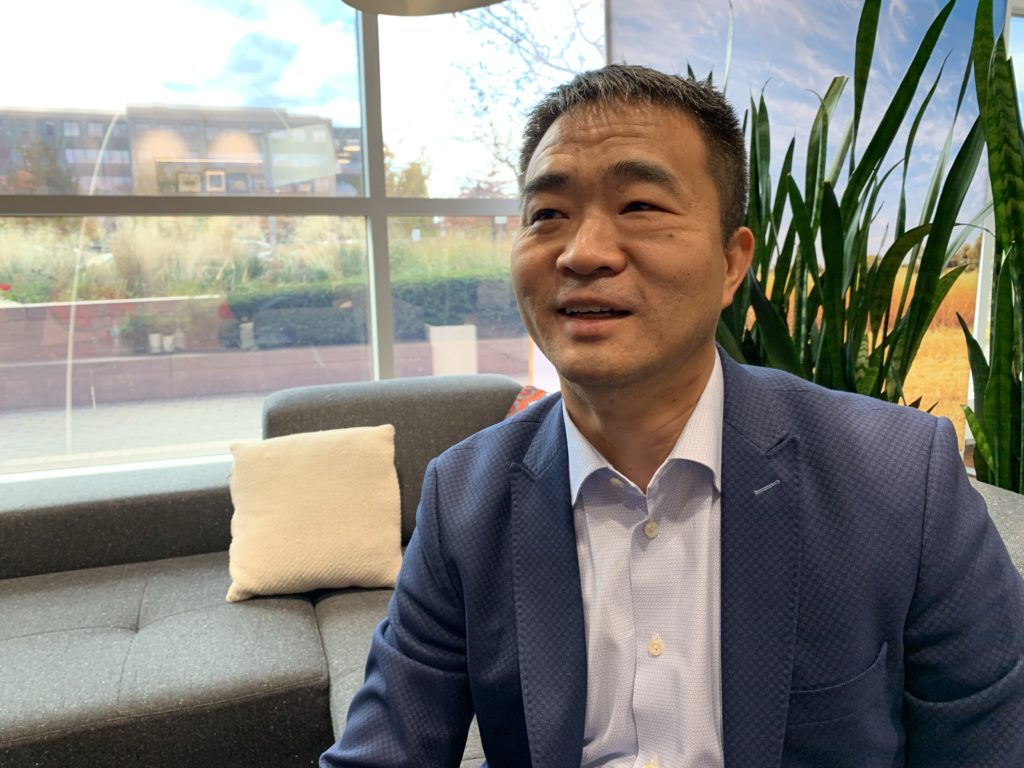
Huawei Canada’s president says that the company will incur a significant loss if it is banned from participating in 5G infrastructure development across the country, but urged that the Chinese tech giant will continue its investment in Canada regardless.
Prime Minister Justin Trudeau has selected his next cabinet, and while he holds a minority government, Huawei executives insist the company’s lobbying and Canadian strategy moving forward will be “diplomatically forceful.”
In interviews with MobileSyrup at its Toronto headquarters in Markham, Ontario, Huawei Canada detailed where it aims to focus its efforts if the company is banned from 5G infrastructure development, as well as its future plans for investing in the country.
Eric Li, the president of Huawei Canada, said that while the company has other partnerships with carriers, not being part of the deployment of 5G will result in a significant monetary loss for the China-based tech giant.
“Yes. I think we will lose revenue,” Li said. “5G is currently the most important technology and we would lose [revenue] for sure [if we are banned]. But we hope to gain from the other sides of business we have, which is our consumer side and enterprise side.”
In its 2018 sales revenue, Huawei Canada revealed it made approximately $566 million CAD, which includes earnings from its carrier and consumer businesses.
Speaking through a translator in February 2019, Liang Hua, one of Huawei’s chairmen, said that number broke down to about $270 million USD (roughly $357 million CAD) in sales revenue from its telecom business and about approximately $150 million USD (about $198 million CAD) from its consumer device business in the Canadian market.
Most of its business is from partnerships with Telus and Bell, the former of which uses 100 percent of network infrastructure in its last-mile network, as well as cellular towers. Telus and Bell have both confirmed that they don’t use Huawei equipment in their core network infrastructure, which is where the most sensitive and vulnerable information is stored.
Li said the company isn’t concerned because it intends to continue its focus on expanding 4G LTE services in rural and remote areas of Canada. Huawei also aims to work on enterprise business solutions such as providing technology for smart agriculture.
Smartphones in Canada
Despite the U.S. ban, Huawei Technologies’ vice-president of public affairs and communications Liu Wei said in an interview that the company felt there was still a space for its products.
“We still have space. We still believe we have some space and our income is rising because our products are really, really good,” Liu said. “But for sure [with no] Google services, for sure, it’s a big matter.”
He said it might take some time, but “one day we will get back to a normal business relationship.”
In May 2019, U.S. President Donald Trump placed Huawei on an Entity List banning the company from working with any U.S.-based company.
The June the ban was lifted to an extent, allowing some companies to apply for a conditional licence. The U.S. also indicated that it was giving companies that currently work with Huawei yet another 90-day extension to find alternative business sources. More recently, the U.S. started granting some companies conditional licences, but it is unclear if Google has made that list.
When Huawei was first placed on the Entity List, Google pulled its business from the company, which meant that future phones would not have access to Google services like YouTube, Maps and thousands of apps in the Play Store.
Globally, Huawei reported a 27 percent revenue jump in Q3 2019 as a result of an increase in smartphone shipments before the U.S. blacklisted the company
Huawei doesn’t break down revenue, but in its earnings said that during the first three quarters of the year, revenue grew 24.4 percent to 610.8 billion yuan (about $113.7 billion CAD).
The first major phone the company released in Canada was the Nova Plus in 2016, followed by the P10 in 2017 and the P20 in 2018. Last year Huawei also launched the Mate 20, its flagship phone.
However, it remains unclear if future Huawei smartphones will be released in Canada.
The company launched its Mate 30 series but indicated that only certain markets would get the phone. The phone lacks Google services and Huawei stated the device would run on the company’s own operating system called HarmonyOS. Huawei has not indicated if the phone will come to Canada.
Recent rumours have indicated that the company’s P40 series will launch in early 2020 to a global audience. Reports suggest that the phone will be similar to the P30 and P30 Pro regarding hardware and software, which means the phone’s operating system would work without Google’s services but would be limited.
Huawei will continue investing in Canada, though U.S. ban creates complex layer
Chris Pereira, director of public affairs at Huawei, said that the company prefers to work with companies it has a long relationship with and regardless of the situation, will continue to prefer working with those companies.
However, Pereira did indicate that this will be challenging for Huawei Canada because of the U.S. ban.
“It will add a layer of complexity in the business for sure. It might change how we approach the strategy, but it won’t change our dedication to Canada” he said, adding that it would try to work with companies to alleviate U.S. ban challenges.
“For example, research and development. It is definitely going to expand because it’s stable and a secure place,” he said. “Ok, there’s a blacklist, but this is not impossible to overcome…we’re still working.”
As previously reported, Huawei Canada has said it wants to expand its already big research and development team in Canada.
In early January, the company reported that it had nearly 1,000 Canadian employees, of which 500 are dedicated to research and development. Huawei announced in February that it was going to invest about $2.6 billion more over five years in research and development and hire 200 more people for the department.
Pereira said that this number is set to grow and that the company will experience a 10 to 15 percent increase in its employees working out of Montreal. There are 50 employees in that location right now.
He also added that the Huawei plans to focus more on enterprise development equipment and artificial intelligence, noting that “Canada has a better environment” for manufacturing.
Liu stated that along with continued efforts concerning investments and products sold in Canada, he isn’t concerned with Huawei Canada’s partnerships.
Huawei has partnered with universities across the country to do research on the future of 5G. Huawei advertisements can also be found on highway billboards, plastered on the walls of malls and even prominently on display during Hockey Night in Canada, of which the company is a title sponsor.
“We are waiting to continue this. We are willing to continue it,” Liu said. “Our contract for Hockey Night in Canada isn’t up for renewal until next year. We have not heard of anything as of now.”
MobileSyrup may earn a commission from purchases made via our links, which helps fund the journalism we provide free on our website. These links do not influence our editorial content. Support us here.




